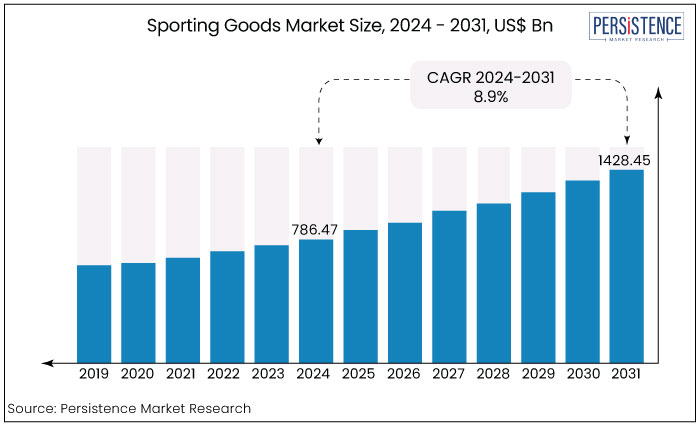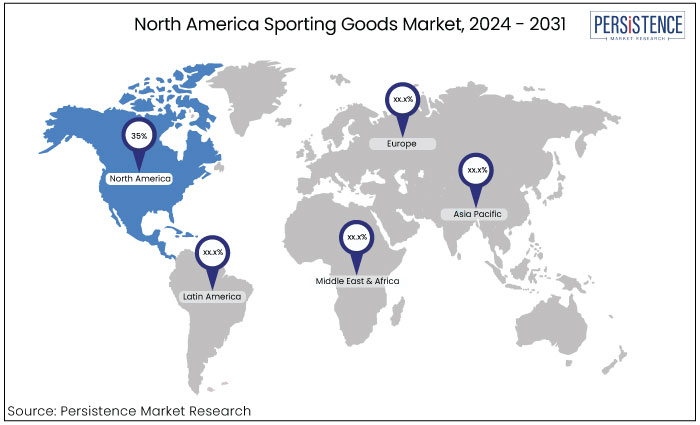Industry: Consumer Goods
Published Date: November-2024
Format: PPT*, PDF, EXCEL
Delivery Timelines: Contact Sales
Number of Pages: 181
Report ID: PMRREP33537
The sporting goods market is estimated to increase from US$786.47 Mn in 2024 to US$1428.45 Mn by 2031. The market is projected to record a CAGR of 8.9 % during the forecast period from 2024 to 2031.
Sports equipment, covering items like golf clubs, soccer gear, and tennis rackets accounted for 25% to 28% of the total market. E-commerce also contributed significant share of sporting good sales in 2022 and is projected to experience a CAGR of around 9% by 2025 due to increasing smartphone usage and digital platforms. Leading players such as Nike, Adidas, and Decathlon dominate with global sporting events such as the FIFA World Cup and the Olympics providing short-term revenue boosts.

Key Highlights of the Market
|
Market Attributes |
Key Insights |
|
Sporting Goods Market Size (2024E) |
US$786.47 Mn |
|
Projected Market Value (2031F) |
US$1428.45 Mn |
|
Global Market Growth Rate (CAGR 2024 to 2031) |
8.9% |
|
Historical Market Growth Rate (CAGR 2019 to 2023) |
10.9% |
|
Region |
Market Share in 2024 |
|
North America |
35% |
The dominant regional market for the sporting goods sector is North America specifically the United States. North America is the dominant region due to a high level of sports participation across various disciplines from professional leagues to recreational activities. The U.S. is home to several leading sporting goods manufacturers such as Nike, Under Armour, and New Balance, which drive both domestic sales and international market.
The growing trend of fitness and wellness, coupled with the increasing popularity of athleisure wear has boosted the demand for sports apparel and equipment. Additionally, a robust distribution network of online and physical retail outlets enhances consumer accessibility.
The region benefits from high consumer spending on premium sporting goods especially in well-established sports leagues. Moreover, government initiatives promoting physical activity and healthy lifestyles have encouraged the adoption of sports products making North America a key player in the sporting goods market.

|
Category |
Market Share in 2024 |
|
Product Type - Apparel |
35% |
The market is further divided into apparel, equipment, and shoes Based on product type. Among these, he apparels segment dominates the market. The apparel segment is expected to expand at a CAGR of 7.5% through 2031. This segment encompasses apparel and accessories designed to enhance the comfort, performance, and style of athletes and fitness enthusiasts across various sports and physical activities.
Companies within this sector continually innovate by introducing novel technologies, materials, and designs to cater to the distinct needs and preferences of individuals engaged in various sports and exercise routines. The advent of athleisure wear, which combines sports performance qualities with casual styling has broadened the market and blurred the distinction between sports apparel and everyday fashion.
|
Category |
Market Share in 2024 |
|
Sales Channel - Independent Stores |
28% |
Based on sales channel, the market is classified into distributors, supermarkets, specialty stores, online stores, and independent stores. Among these, the independent stores segment dominates the market.
Sales of sporting goods through independent sports stores are anticipated to progress at a noteworthy CAGR of 10.4% over the forecast period. Independent sports stores play an important role in enhancing the variety and accessibility of sports-related products.
Independent sports stores cater to niche markets by focusing on certain sports or recreational activities and offering specialized equipment for sports such as soccer, tennis, golf, cycling, hiking, or water sports.
Specializing allows sports stores to offer a tailored and curated range of merchandise, catering directly to enthusiasts of specific sports. This specialization makes independent sports stores a compelling sales channel choice for consumers. Soccer gear accounts for particularly high sales since it is the most popular sport globally.
Sporting goods are a large category of designed equipment, gear, and accessories. These products are designed to improve the performance, safety, and experience of athletes and individuals participating in sports and fitness activities.
Participating in recreational sports, fitness training, competitive athletics, and outdoor activities require sporting equipment. These items are developed to meet specific performance standards, safety regulations, and ergonomic considerations, allowing users to enjoy their favourite sports and activities while limiting the chance of injury.
The environment is dynamic and ever-changing in terms of market competition with companies attempting to differentiate themselves through product innovation, brand positioning, marketing techniques, and responsive customer service. The capacity to adapt to shifting consumer tastes and market trends is critical for maintaining a competitive edge in this broad and competitive industry.
The sporting goods market experienced steady growth during the historical period from 2019 to 2023 driven by rising awareness of health and fitness, the global popularity of sports events, and increased participation in recreational activities.
The market benefited from key trends like the athleisure boom, a growing consumer preference for fitness apparel that doubles as casual wear from 2019 to 2023. The rise of e-commerce also expanded the accessibility of sporting goods, allowing consumers to easily purchase products online.
Post-2024, the market is expected to grow substantially due to ongoing health and wellness trends, the resumption of large-scale sporting events, and technological innovations in sporting goods. Market growth is also projected to come from increased digital integration such as wearables and smart sports equipment, which provide real-time performance tracking.
Sustainable and eco-friendly products are estimated to gain prominence as consumers become environmentally conscious. Additionally, emerging markets in Asia Pacific particularly China and India are anticipated to be a key growth driver due to rising disposable incomes and government initiatives promoting sports participation.
Rising Global Participation in Sports and Outdoor Recreational Activities
The popularity of sports, both amateur and professional, has risen in recent years, and as more people participate in sports activities, there is a great need for sporting items such as equipment, footwear, and apparel.
Outdoor recreational pursuits like hiking, camping, cycling, and water sports have seen a rise in popularity as a result of the pandemic as people look for safe ways to exercise and engage in leisure activities. This pattern has boosted sales of outdoor sporting goods.
Technological Advancements in Sporting Goods
Technological innovations are another major growth driver for the sporting goods market. Advances in materials, design, and functionality have led to the development of performance-enhancing sports equipment and gear. For example, lightweight, durable materials like carbon fiber and advanced polymers have revolutionized products such as tennis rackets, bicycles, and running shoes, offering enhanced performance and comfort.
Wearable technology such as fitness trackers and smart clothing has gained widespread adoption, allowing users to monitor and optimize their physical activity. These advancements improve athletic performance and attract a broad audience, including tech-savvy consumers interested in integrating fitness into their daily routines. The continuous evolution of smart, connected sporting goods is likely to drive further growth in the market as more people look for data-driven ways to improve their physical performance.
Wide Availability of Unsafe Counterfeit Products Weaken Brand Loyalty
Consumers’ preferences change quickly especially with the rise of social media and influencer marketing. Companies struggle to keep up with shifting trends and preferences, which has an impact on their capacity to produce and promote consumer-friendly products. To avoid this risk, businesses should invest in market research to keep track of current trends and collaborate closely with influencers and social media platforms.
The sporting goods industry is also vulnerable to creating and selling counterfeit items, which can weaken customer trust in authentic brands and impact product sales. Counterfeit items can also represent a safety concern to consumers unaware they are acquiring a counterfeit product, as these products may not meet safety regulations or go through necessary quality control inspections, thereby putting consumers in danger.
Expansion of Digital and Connected Sports Equipment
Integrating digital technology and Internet of Things (IoT) into sporting goods presents a transformative opportunity. Connected sports equipment, such as smart basketballs, tennis rackets, and even smart clothing, allows athletes to track their performance data in real-time. This fusion of physical sports equipment with digital tracking and analytics offers tremendous growth potential as more amateur and professional consumers demand data-driven insights to enhance their skills and fitness levels.
Products like Wilson’s Smart Basketball or Babolat Play Smart Tennis Rackets have sensors embedded that track metrics such as ball speed, spin rate, shot accuracy and more. Paired with apps, these products provide users with performance breakdowns and tailored recommendations.
The said opportunity is transformative as it blurs the line between physical products and digital solutions, creating a personalized and engaging performance athletic experience. In the future, AI-driven virtual coaching and real-time feedback could become a dominant feature of high-performance training tools, offering athletes at all levels the ability to enhance their skills without requiring a coach.
The competitive landscape of the sporting goods market is characterized by the presence of both established global brands and innovative newcomers.
Key players include Nike, Adidas, Under Armour, Puma, and Decathlon, dominating the market with extensive product portfolios, strong brand equity, and vast distribution networks. These companies leverage advanced technology, sustainability initiatives, and celebrity endorsements to maintain market share.
New entrants and niche brands like Lululemon in activewear and Babolat in smart sports equipment focus on innovation and specialized products to capture targeted consumer segments. E-commerce growth has also intensified competition, with brands like Amazon and Alibaba expanding their sporting goods offerings. The market is highly competitive, driven by innovation, technological integration, and evolving consumer preferences.
Recent Industry Developments in the Sporting Goods Market
|
Attributes |
Details |
|
Forecast Period |
2024 to 2031 |
|
Historical Data Available for |
2019 to 2023 |
|
Market Analysis |
US$ Billion for Value |
|
Key Regions Covered |
|
|
Key Market Segments Covered |
|
|
Key Companies Profiled in the Report |
|
|
Report Coverage |
|
|
Customization & Pricing |
Available upon request |
By Product Type
By Sales Channel
By End User
By Region
To know more about delivery timeline for this report Contact Sales

The market is estimated to be valued at US$1428.45 Mn by 2031
The market is projected to exhibit a CAGR of 8.9% over the forecast period.
Adidas AG, Nike, Inc., Under Armour, Inc., are some of the key players.
North America dominates the market for sporting goods.
The market share is valued at US$786.47 Mn in 2024.